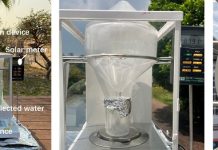
Imagine a world where checking your water for harmful chemicals is as easy as taking a pregnancy test. This isn’t a fantasy, thanks to a group of chemists from MIT. They’ve developed a sensor that can find tiny amounts of dangerous substances called PFAS in water.
PFAS are chemicals used in lots of everyday items, like food packaging, non-stick pans, and waterproof clothes. They’re called “forever chemicals” because they don’t break down naturally and can stay in the environment for a very long time.
These chemicals can be really bad for our health, linked to serious issues like cancer, fertility problems, and harm to our immune and hormonal systems.
With the new sensor the MIT team created, detecting these substances in water has become easier and could one day be something anyone can do at home.
PFAS have been used since the 1950s and can spread into the water, air, and ground from various sources, including factories and landfills.
The problem is so widespread that they’re found in drinking water all across the United States. Recognizing the danger, the Environmental Protection Agency (EPA) has set extremely low safety limits for these chemicals in water.
Up until now, if you wanted to check your water for PFAS, you’d have to send a sample to a lab, wait a few weeks, and pay a lot of money. The MIT team, led by Professor Timothy Swager, decided there had to be a better way.
They came up with a sensor that works a bit like those rapid tests for COVID-19 or pregnancy tests you can buy at the store. Instead of looking for viruses or hormones, though, this sensor looks for PFAS.
The sensor uses a special kind of plastic on a strip of paper. When a drop of water with PFAS in it touches the strip, the plastic reacts and changes how electricity flows through it.
By measuring this change, the sensor can tell how much PFAS is in the water and send the info to a smartphone or another device.
Right now, it can detect some of the most dangerous PFAS at levels as low as parts per trillion, although it’s not yet sensitive enough to meet the EPA’s strictest guidelines.
The team isn’t stopping there. They’re working on a bigger version that could test a whole liter of water by filtering it through a membrane coated with the special plastic. This should make the sensor even more sensitive, hopefully meeting those EPA standards.
The goal is to make a device that’s easy for anyone to use at home. You’d just need to run some water through the device, and it would tell you if your water is safe or if you need to filter it to get rid of the PFAS.
This invention could be a game-changer, not just for ordinary folks worried about their drinking water, but also for industries that use PFAS. They could use it to make sure the water they’re putting back into the environment is safe.
With this new sensor, detecting “forever chemicals” in our water might soon be simple, quick, and affordable.
The research findings can be found in PNAS.
Copyright © 2024 Knowridge Science Report. All rights reserved.



